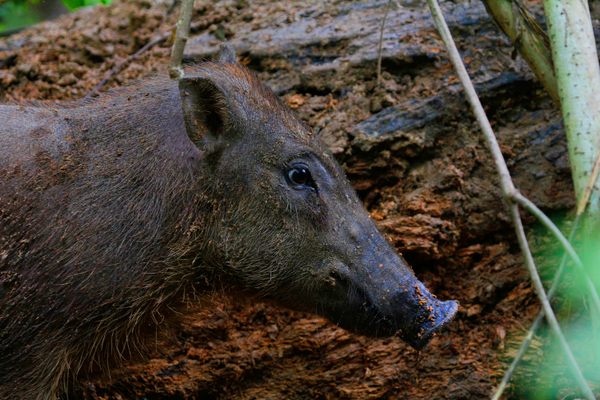Wild Life: Gynandromorphs
In a preview of our new book, we meet beautiful nonbinary animals that combine male and female characteristics.
Each week, Atlas Obscura is providing a new short excerpt from our upcoming book, Wild Life: An Explorer’s Guide to the World’s Living Wonders (September 17, 2024).
In the winter of 2019, a bird went viral. “This nonbinary cardinal is flipping gender the bird,” announced the queer news site Logo TV, showing a bird with distinct half-red and half-tawny plumage, as though split down the middle.
The cardinal (or their doppelgänger) reentered the limelight in 2021, having been spotted in the same region of the northeast United States. As similar headlines followed, the large songbird became one of the best-known recent gynandromorphs—organisms that exhibit both male and female physical characteristics at the same time.
These characteristics can be displayed bilaterally, as with the cardinal, zebra finches, or a rose-breasted grosbeak found in Pennsylvania in 2020 with two different colored inner wings, yellow on the left and pink on the right. Bilateral gynandromorphs are sometimes called “halfsiders” or “chimeras.” Halfsiders are particularly striking when the species is sexually dimorphic, meaning males and females have different physical characteristics.

The second-largest butterfly in the world, the Goliath birdwing of New Guinea, can also appear as a halfsider. Goliath birdwing gynandromorphs have different sized and colored wings, making them look like patchwork creatures. Many butterfly and moth chimeras have become important symbols in intersex and nonbinary human communities.
While it isn’t something you see every day, gynandromorphism does happen in a variety of animals besides birds and butterflies, including other insects, reptiles, crustaceans, and even some mammals, like rats. But because many species are not sexually dimorphic, it isn’t always immediately noticeable.
Scientists believe that gynandromorphism is mainly attributable to genetic mutations associated with cell division. As these mutations occur at different stages of development, they produce different types of gynandromorphs. While many are bilateral, some present as mosaics, meaning male and female characteristics are splashed across the organism’s body like tie-dye—as with some gynandromorphic Pamela and blue morpho butterflies. Others are polar, meaning the dividing line occurs elsewhere on the animal’s body.
This phenomenon challenges assumptions about the natural world. For instance, in some types of ants, gynandromorph queen-males have been found, with one black, winged male side and one red queen side. Even in species that tend toward rigid sex roles, individuals have a way of surprising us.

- Range: Worldwide
- Major species: Some of the most striking gynandromorphs commonly seen include northern cardinals (Cardinalis cardinalis), Goliath birdwings (Ornithoptera goliath), and jumping spiders (Myrmarachne formicaria).
- How to see them: Finding a gynandromorph in the wild takes patience and regular observation—either that or a ton of luck. Many examples can be seen online and in museums.
Wild Life: An Explorer’s Guide to the World’s Living Wonders celebrates hundreds of surprising animals, plants, fungi, microbes, and more, as well as the people around the world who have dedicated their lives to understanding them. Pre-order your copy today!




































Follow us on Twitter to get the latest on the world's hidden wonders.
Like us on Facebook to get the latest on the world's hidden wonders.
Follow us on Twitter Like us on Facebook